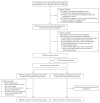Randomized Trial of Fetal Surgery for Moderate Left Diaphragmatic Hernia
- PMID: 34106555
- PMCID: PMC7613454
- DOI: 10.1056/NEJMoa2026983
Randomized Trial of Fetal Surgery for Moderate Left Diaphragmatic Hernia
Abstract
Background: Fetoscopic endoluminal tracheal occlusion (FETO) has been associated with increased postnatal survival among infants with severe pulmonary hypoplasia due to isolated congenital diaphragmatic hernia on the left side, but data are lacking to inform its effects in infants with moderate disease.
Methods: In this open-label trial conducted at many centers with experience in FETO and other types of prenatal surgery, we randomly assigned, in a 1:1 ratio, women carrying singleton fetuses with a moderate isolated congenital diaphragmatic hernia on the left side to FETO at 30 to 32 weeks of gestation or expectant care. Both treatments were followed by standardized postnatal care. The primary outcomes were infant survival to discharge from a neonatal intensive care unit (NICU) and survival without oxygen supplementation at 6 months of age.
Results: In an intention-to-treat analysis involving 196 women, 62 of 98 infants in the FETO group (63%) and 49 of 98 infants in the expectant care group (50%) survived to discharge (relative risk , 1.27; 95% confidence interval [CI], 0.99 to 1.63; two-sided P = 0.06). At 6 months of age, 53 of 98 infants (54%) in the FETO group and 43 of 98 infants (44%) in the expectant care group were alive without oxygen supplementation (relative risk, 1.23; 95% CI, 0.93 to 1.65). The incidence of preterm, prelabor rupture of membranes was higher among women in the FETO group than among those in the expectant care group (44% vs. 12%; relative risk, 3.79; 95% CI, 2.13 to 6.91), as was the incidence of preterm birth (64% vs. 22%, respectively; relative risk, 2.86; 95% CI, 1.94 to 4.34), but FETO was not associated with any other serious maternal complications. There were two spontaneous fetal deaths (one in each group) without obvious cause and one neonatal death that was associated with balloon removal.
Conclusions: This trial involving fetuses with moderate congenital diaphragmatic hernia on the left side did not show a significant benefit of FETO performed at 30 to 32 weeks of gestation over expectant care with respect to survival to discharge or the need for oxygen supplementation at 6 months. FETO increased the risks of preterm, prelabor rupture of membranes and preterm birth. (Funded by the European Commission and others; TOTAL ClinicalTrials.gov number, NCT00763737.).
Copyright © 2021 Massachusetts Medical Society.
Figures

Comment in
-
Fetal Tracheal Occlusion for Congenital Diaphragmatic Hernia.N Engl J Med. 2021 Jul 8;385(2):177-178. doi: 10.1056/NEJMe2107446. Epub 2021 Jun 8. N Engl J Med. 2021. PMID: 34106554 No abstract available.
References
-
- Ameis D, Khoshgoo N, Keijzer R. Abnormal lung development in congenital diaphragmatic hernia. Semin Pediatr Surg. 2017;26:123–8. - PubMed
-
- Harting MT, Lally KP. The Congenital Diaphragmatic Hernia Study Group registry update. Semin Fetal Neonatal Med. 2014;19:370–5. - PubMed
-
- Section on Surgery and the Committee on Fetus and Newborn. Postdischarge follow-up of infants with congenital diaphragmatic hernia. Pediatrics. 2008;121:627–32. - PubMed
-
- Jani J, Nicolaides KH, Keller RL, et al. Observed to expected lung area to head circumference ratio in the prediction of survival in fetuses with isolated diaphragmatic hernia. Ultrasound Obstet Gynecol. 2007;30:67–71. - PubMed
-
- Dekoninck P, Gratacos E, Van Mieghem T, et al. Results of fetal endoscopic tracheal occlusion for congenital diaphragmatic hernia and the set up of the randomized controlled TOTAL trial. Early Hum Dev. 2011;87:619–24. - PubMed
Publication types
MeSH terms
Associated data
Grants and funding
LinkOut - more resources
Full Text Sources
Other Literature Sources
Medical
